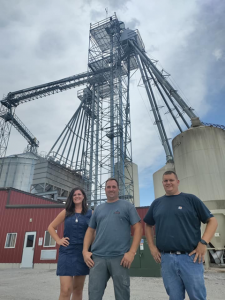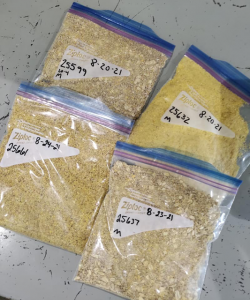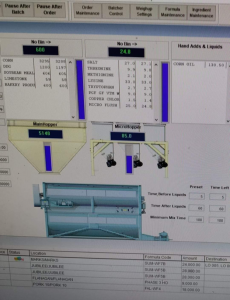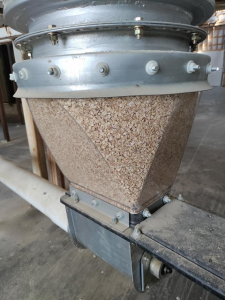Did you ever wonder what all is in livestock feed? The answer is, all sorts of good stuff! Animal feed — whether livestock or pets — is specially formulated with the intent to create a balanced diet for our critters. So, it was exciting to see one segment of this industry, pig feed, up close and personal in Iowa.
I toured County Line Feed Mill in Iowa. Here, they receive corn from local farmers and process 750 tons of feed per week! Iowa is known for its pork and is the most productive state in the country for it (by a lot!).

Adult pigs eat around six pounds of feed per day, and they grow fast naturally! A pig can grow from birth to 250 pounds or so in around six months. There is no such thing as added hormones or steroids in pork, but specially formulated feeds can help them grow faster. Overall, this is good for the environment as it can help produce more pork with fewer resources.
What about antibiotics? Oftentimes people believe that antibiotics are routinely given to livestock in Confined Animal Feeding Operations, also known as CAFOs (large-scale farms). However, there are many regulations in place to ensure that farms work closely with veterinarians to only utilize medicine when needed.
A lot has changed in recent years. Improvements in housing, genetics, biosecurity, ventilation, and other aspects create an environment where a lot of livestock can be raised with no antibiotics ever. The Veterinary Feed Directive (VFD), which provided veterinarians with a framework for using medically important antimicrobials when needed for specific animal health purposes, has been in effect since 2017 and changed how antibiotics have been used.
If they are needed, antibiotics are still an important tool for animal welfare. And if a farm’s veterinarian deems them necessary, there are three ways which they can be administered:
- Injectable. Probably the most common and preferred method, as it means animals can be cared for individually rather than an overall group.
- Through the water. Modern pig barns have impressive feed and water efficiency systems. If an entire groups needs attention, administering antibiotics through a water system ensures every animal in the group gets that medicine, by drinking through the same automatic pig waterers.
- Through the feed. This is the least preferred method to administer antibiotics, however it does still happen at times if it’s really necessary.
But here’s what’s interesting about medicated feed like this: Samples of feed must be saved for two years! Here, County Line Feed Mill keeps samples of every feed they use with a date and number that’s tied to a farm in their computer system.

Why do they do this? Well, by federal law all meat sold to consumers in the United States must be antibiotic-free. So if medication is needed, there’s a “withdrawal period” before any animal can go to market to ensure that any drug residue is no longer in their system. By the time the medicine has worn off, the meat we eat does not have any antibiotics in it. Period. By law. Don’t let the “antibiotic free” label fool you. It is all that way!
But let’s say someone makes a mistake. Pork processing plants do test for antibiotics. And if the pigs test positive, their feed is traced back to the feed mill, the meat is destroyed, and the business is fined and must pay for loss and damages. Issues like this are extremely rare and for good reason!
Modern day feed mills really are impressive. Here, County Line Feed Mill’s computer system has each farmer customer tied to a number and can track down what feed goes where. DDG stands for dry distillers grain, a byproduct of corn ethanol plants. Bakery products can be from factories that make cakes and donuts — because yes, sugar can be a good source of carbohydrates for them, and it’s better than some of these less-than-perfect treats ending up in a landfill!
This is a photo of their computer screen, which breaks it down. The long, fancy sounding words (ending in “ine” for example) are just an elaborate way of describing what vitamin or nutrient it is.

They have bulk bins with different ingredients like oats, corn, vitamins, minerals, and nutrients. Other products may be added to aid with digestion, which is sort of like essential oils — naturally derived products from oregano and oregano oil have been scientifically proven to help keep them healthy as well.

After feeds are mixed and trucks are loaded up with the feed and cracked corn or whatever is needed, these feed orders will be trucked off to the farm!
Feed varies for the age of the pig too, from weaning on up to full grown — there is a lot of impressive science that goes into animal feed to ensure the happiest and most healthy farm-raised pork.
Michelle Miller, the Farm Babe, is a farmer, public speaker and writer who has worked for years with row crops, beef cattle, and sheep. She believes education is key in bridging the gap between farmers and consumers.



